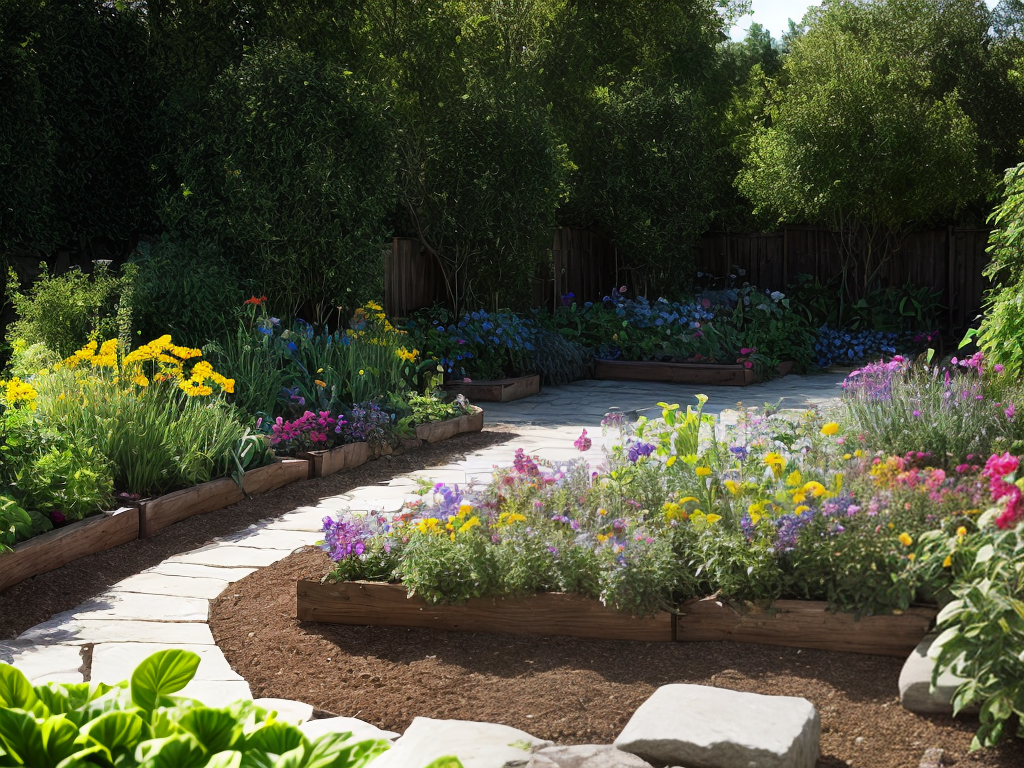
Have you ever wondered how you can create a beautiful and sustainable garden right in your own backyard? Well, look no further because in this discussion, I will provide you with practical tips and techniques to achieve just that. From choosing the right plants to attracting beneficial wildlife, this paragraph is just the beginning of a journey towards a greener and more sustainable garden. So, let’s dig in and discover the secrets to creating a thriving and eco-friendly outdoor space that you can be proud of.
Choosing the Right Plants
When selecting plants for your sustainable garden, it is crucial to choose species that are well-suited to your specific climate and soil conditions. Proper plant selection is the foundation of a successful and thriving garden. By choosing the right plants, you can minimize the need for excessive watering, fertilizers, and pesticides, ultimately reducing your garden’s environmental impact.
To start, consider the climate in your area. Research which plants thrive in your specific region and choose those that are best adapted to the local conditions. Look for plants that are drought-tolerant, as they require less water and can withstand periods of dry weather. Additionally, select plants that are native to your area, as they have evolved to thrive in the local ecosystem.
Next, assess your soil conditions. Different plants have different soil requirements, so it’s important to choose species that can grow well in your soil type. Conduct a soil test to determine its pH level and nutrient content. This will help you select plants that can thrive in your soil and reduce the need for excessive fertilizers.
Lastly, consider the size and growth habit of the plants you choose. Proper spacing and placement will allow plants to grow to their full potential without competing for resources. This will also prevent overcrowding and promote air circulation, reducing the risk of diseases.
Implementing Water Conservation Techniques
Now let’s explore effective ways to conserve water in your sustainable garden. Here are some techniques you can implement to save water and promote a more eco-friendly garden:
-
Rainwater Harvesting: Install a rainwater collection system to capture and store rainwater for later use in your garden. This reduces your reliance on municipal water sources and helps you save money on your water bill.
-
Drip Irrigation: Use drip irrigation systems instead of traditional sprinklers to deliver water directly to the roots of your plants. This method minimizes water wastage through evaporation and ensures that water is used efficiently.
-
Mulching: Apply a layer of organic mulch around your plants to retain moisture in the soil. This helps to prevent water evaporation, reduces weed growth, and improves soil health.
-
Watering at the Right Time: Water your garden early in the morning or late in the evening when temperatures are cooler. This reduces water loss from evaporation and allows plants to absorb water more effectively.
-
Grouping Plants by Water Needs: Group plants with similar water requirements together. This way, you can avoid overwatering or underwatering certain plants and ensure that each plant receives just the right amount of water.
Building Healthy Soil
To ensure a thriving sustainable garden, it is crucial to focus on building and maintaining healthy soil. Healthy soil provides the necessary nutrients and support for plants to grow strong and resist diseases and pests. There are two key strategies that can help improve the health of your soil: improving drainage and using cover crops.
Improving drainage is essential for healthy soil. Excess water can cause soil compaction and lead to root rot. To improve drainage, you can incorporate organic matter such as compost or well-rotted manure into the soil. This will help loosen the soil and promote better water movement. Additionally, adding perlite or vermiculite can also improve drainage by increasing soil aeration.
Using cover crops is another effective way to build healthy soil. Cover crops, such as clover or rye grass, can be planted during fallow periods to protect the soil from erosion and nutrient depletion. They also help to break up compacted soil and improve its structure. When the cover crops are eventually turned into the soil, they add organic matter and nutrients, enriching the soil for future plantings.
By implementing these strategies, you can create a healthy and sustainable garden that will thrive for years to come.
| Improving Drainage | Using Cover Crops |
|---|---|
| Incorporate organic matter | Plant cover crops during fallow periods |
| Add perlite or vermiculite | Protect soil from erosion and nutrient depletion |
| Loosen soil and promote better water movement | Break up compacted soil and improve structure |
| Prevent soil compaction and root rot | Enrich soil with organic matter and nutrients |
Controlling Pests and Weeds Naturally
Controlling pests and weeds naturally is key to maintaining a sustainable garden. By using natural pest control methods, such as companion planting and insect-repelling plants, I can avoid harmful chemicals and protect the health of my garden. Additionally, organic weed management techniques, like mulching and hand weeding, help to keep weeds at bay without the use of synthetic herbicides. Finally, attracting beneficial insects, such as ladybugs and lacewings, can provide a natural form of pest control, keeping harmful insects in check.
Natural Pest Control Methods
Using natural pest control methods is an effective and environmentally-friendly way to manage pests and weeds in your garden. Here are some methods you can try:
- Companion planting: Planting certain crops together to deter pests. For example, marigolds can repel aphids and nematodes when planted near tomatoes.
- Homemade remedies: Creating your own pest control solutions using ingredients like garlic, vinegar, and soap. These can be sprayed directly on pests to deter them.
- Attracting beneficial insects: Encouraging beneficial insects like ladybugs and lacewings by planting flowers that attract them. These insects prey on pests, keeping their populations in check.
- Crop rotation: Rotating your crops each year to prevent the buildup of pests and diseases. This disrupts their life cycles and reduces the risk of infestation.
- Mulching: Applying mulch around your plants to suppress weed growth. This not only helps control weeds but also retains moisture in the soil, reducing the need for watering.
Organic Weed Management
Implementing organic weed management techniques is essential for maintaining a healthy and sustainable garden. Instead of relying on harmful chemicals, I recommend utilizing natural methods such as composting techniques and companion planting. Composting can help create nutrient-rich soil that suppresses weed growth. By adding organic matter such as kitchen scraps and yard waste to a compost pile, you can create a fertile environment for your plants while smothering weeds. Additionally, companion planting involves strategically placing certain plants together to deter weeds. For example, planting marigolds alongside vegetables can repel pests and inhibit weed growth. To further convey the benefits of organic weed management, here is a table showcasing the advantages of composting and companion planting:
| Composting Techniques | Companion Planting |
|---|---|
| Improves soil fertility | Natural pest control |
| Suppresses weed growth | Enhances biodiversity |
| Reduces the need for synthetic fertilizers | Maximizes garden space |
Beneficial Insects for Pest Control
To continue our exploration of sustainable garden practices, let’s now explore the role of beneficial insects in naturally controlling pests and weeds. These insects play a crucial role in maintaining a healthy garden ecosystem by preying on harmful insects and pollinating plants. Here are five ways to attract beneficial insects for organic pest control:
- Plant a diverse range of flowering plants to attract pollinators like bees and butterflies.
- Provide shelter and nesting sites for beneficial insects by incorporating native plants, rocks, and logs into your garden.
- Avoid using chemical pesticides that can harm beneficial insects.
- Use companion planting techniques to attract beneficial insects that prey on specific pests.
- Create an inviting habitat by providing a water source, such as a shallow dish with rocks for bees to land on.
Using Sustainable Garden Design Principles
Incorporating sustainable garden design principles is essential for creating an environmentally-friendly and thriving garden. By following these sustainable garden design tips, you can ensure that your garden not only looks beautiful but also supports the ecosystem and conserves resources. Here are some key principles to keep in mind when planning your sustainable garden landscaping:
| Principles | Benefits | Examples |
|---|---|---|
| Reduce water usage | Conservation of water resources | Install drip irrigation systems, use mulch to retain moisture |
| Choose native plants | Support local biodiversity | Plant native species that are adapted to the local climate and require less maintenance |
| Implement composting | Improve soil fertility | Create a compost pile or use a compost bin to recycle organic waste |
| Minimize chemical use | Promote a healthy ecosystem | Use organic fertilizers and natural pest control methods |
Composting and Recycling Garden Waste
One crucial aspect of maintaining a sustainable garden is effectively managing and repurposing garden waste. By composting and recycling garden waste, we can create nutrient-rich soil amendments and reduce the amount of waste sent to landfills. Here are some composting techniques and recycling methods to help you make the most of your garden waste:
-
Composting: Start a compost pile or use a compost bin to break down organic materials like leaves, grass clippings, and kitchen scraps. Turn the pile regularly to aerate and speed up decomposition. Remember to maintain the right balance of carbon-rich (browns) and nitrogen-rich (greens) materials for optimal composting.
-
Mulching: Use shredded leaves or wood chips as mulch in your garden beds. Mulch helps retain moisture, suppress weeds, and add organic matter to the soil as it breaks down.
-
Grasscycling: Leave grass clippings on the lawn after mowing. This practice returns nutrients to the soil and reduces the need for synthetic fertilizers.
-
Leaf Mold: Collect fallen leaves in a separate compost pile or bin. Over time, the leaves will decompose into a dark, crumbly substance called leaf mold, which makes an excellent soil amendment.
-
Recycling: If you have yard waste that can’t be composted, check with your local recycling center to see if they accept green waste for recycling. They may have facilities that can process and reuse these materials.
Attracting Beneficial Wildlife to Your Garden
When it comes to creating a sustainable garden, attracting beneficial wildlife is key. By selecting wildlife-friendly plants, such as native species, you can provide a valuable food source and habitat for birds, butterflies, and other beneficial insects. Additionally, providing water sources and creating shelter, such as birdhouses and bee hotels, will further encourage wildlife to visit and thrive in your garden.
Wildlife-Friendly Plant Selection
To attract beneficial wildlife to your garden, carefully select plants that provide food and shelter for various species. By choosing native plant species and creating a pollinator-friendly landscaping, you can create an inviting habitat for beneficial wildlife. Here are five key considerations for selecting wildlife-friendly plants:
- Choose a variety of flowering plants that bloom throughout the seasons to provide a consistent food source for pollinators.
- Include plants with different heights and structures to create diverse habitats for wildlife to rest and seek shelter.
- Opt for plants that produce berries, seeds, or nectar to attract birds, butterflies, and other beneficial insects.
- Avoid using pesticides or chemicals on your plants, as they can harm wildlife and disrupt the natural balance of your garden.
- Incorporate plants that have specific relationships with certain wildlife, such as milkweed for monarch butterflies or host plants for caterpillars.
Providing Water and Shelter
To create an inviting habitat for beneficial wildlife in your garden, it is important to provide water sources and shelter options. Creating wildlife-friendly habitats involves making sure that there are adequate water sources available for the animals. This can be done by installing bird baths, ponds, or even a small water feature. It is also crucial to offer shelter options for wildlife, such as birdhouses, bat boxes, or dense shrubs and trees. These shelters provide a safe place for animals to rest, nest, and seek protection from predators. Additionally, providing food sources like native plants and flowers that produce seeds, fruits, or nectar will attract a variety of wildlife to your garden. By incorporating these elements into your garden, you can create a sustainable and welcoming environment for beneficial wildlife.





